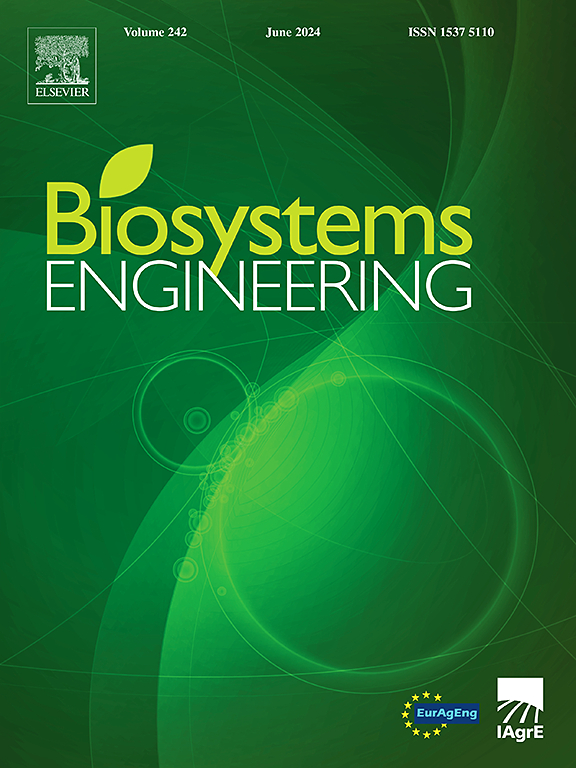Deep learning-based model to classify mastitis in Holstein dairy cows
IF 4.4
1区 农林科学
Q1 AGRICULTURAL ENGINEERING
引用次数: 0
Abstract
The occurrence and prevalence of dairy cow mastitis has brought significant challenges to animal welfare and economy. To overcome the complexities and accumulated errors present in previous detection methods, a rapid and accurate mastitis detection approach is developed based on image processing and deep learning, leveraging thermal infrared imaging. Image processing techniques, including the Hough transform and morphological operations, are used to classify affected cows from thermal images. An image pyramid is constructed based on upsampling to tackle motion blur induced by the cows' rapid movement. The multi-scale convolution and the spatial and channel Squeeze & Excitation (scSE) block were integrated into the DenseNet-201 architecture to enhance the feature extraction process. This enabled the network to adaptively recalibrate channel-wise feature responses and strengthening the discriminative power of the learned representations. For mastitis detection, a deep learning model, the multi-scale scSE-DenseNet-201 (MS-scSE-DenseNet-201) architecture, is refined to predict the severity of mastitis. The framework takes images of both sides of the cow's udder as input, and outputs one of three mastitis severity levels: negative (N), subclinical mastitis (SCM), or clinical mastitis (CM). To assess the model's performance in detecting mastitis, a dataset comprising 5000 thermal images from 802 cows, was used. The model achieved accuracy, precision, and recall of 90.18%, 92.16%, and 88.38%, respectively, showing notable improvement over previous methods. This work integrated object segmentation and blind deblurring to strengthen the MS-scSE-DenseNet-201 in the automatic detection of cow mastitis, which will open a promising application horizon for other animal disease diagnostics.
基于深度学习的荷斯坦奶牛乳腺炎分类模型
奶牛乳腺炎的发生和流行给动物福利和经济带来了重大挑战。为了克服以往检测方法的复杂性和累积误差,基于图像处理和深度学习,利用热红外成像技术,开发了一种快速准确的乳腺炎检测方法。图像处理技术,包括霍夫变换和形态学操作,用于从热图像中对受影响的奶牛进行分类。基于上采样构造图像金字塔,解决奶牛快速运动引起的运动模糊问题。多尺度卷积与空间和通道挤压将激励(scSE)块集成到DenseNet-201架构中,以增强特征提取过程。这使得网络能够自适应地重新校准通道特征响应,并加强学习表征的判别能力。对于乳腺炎的检测,一个深度学习模型,多尺度scSE-DenseNet-201 (MS-scSE-DenseNet-201)架构,被改进来预测乳腺炎的严重程度。该框架将奶牛乳房两侧的图像作为输入,并输出三种乳腺炎严重程度中的一种:阴性(N)、亚临床乳腺炎(SCM)或临床乳腺炎(CM)。为了评估该模型在检测乳腺炎方面的性能,使用了一个包含来自802头奶牛的5000张热图像的数据集。该模型的准确率、精密度和召回率分别为90.18%、92.16%和88.38%,与之前的方法相比有显著提高。本研究将目标分割和盲去模糊相结合,增强了MS-scSE-DenseNet-201在奶牛乳腺炎自动检测中的应用,为其他动物疾病的诊断开辟了广阔的应用前景。
本文章由计算机程序翻译,如有差异,请以英文原文为准。
求助全文
约1分钟内获得全文
求助全文
来源期刊

Biosystems Engineering
农林科学-农业工程
CiteScore
10.60
自引率
7.80%
发文量
239
审稿时长
53 days
期刊介绍:
Biosystems Engineering publishes research in engineering and the physical sciences that represent advances in understanding or modelling of the performance of biological systems for sustainable developments in land use and the environment, agriculture and amenity, bioproduction processes and the food chain. The subject matter of the journal reflects the wide range and interdisciplinary nature of research in engineering for biological systems.
 求助内容:
求助内容: 应助结果提醒方式:
应助结果提醒方式:


